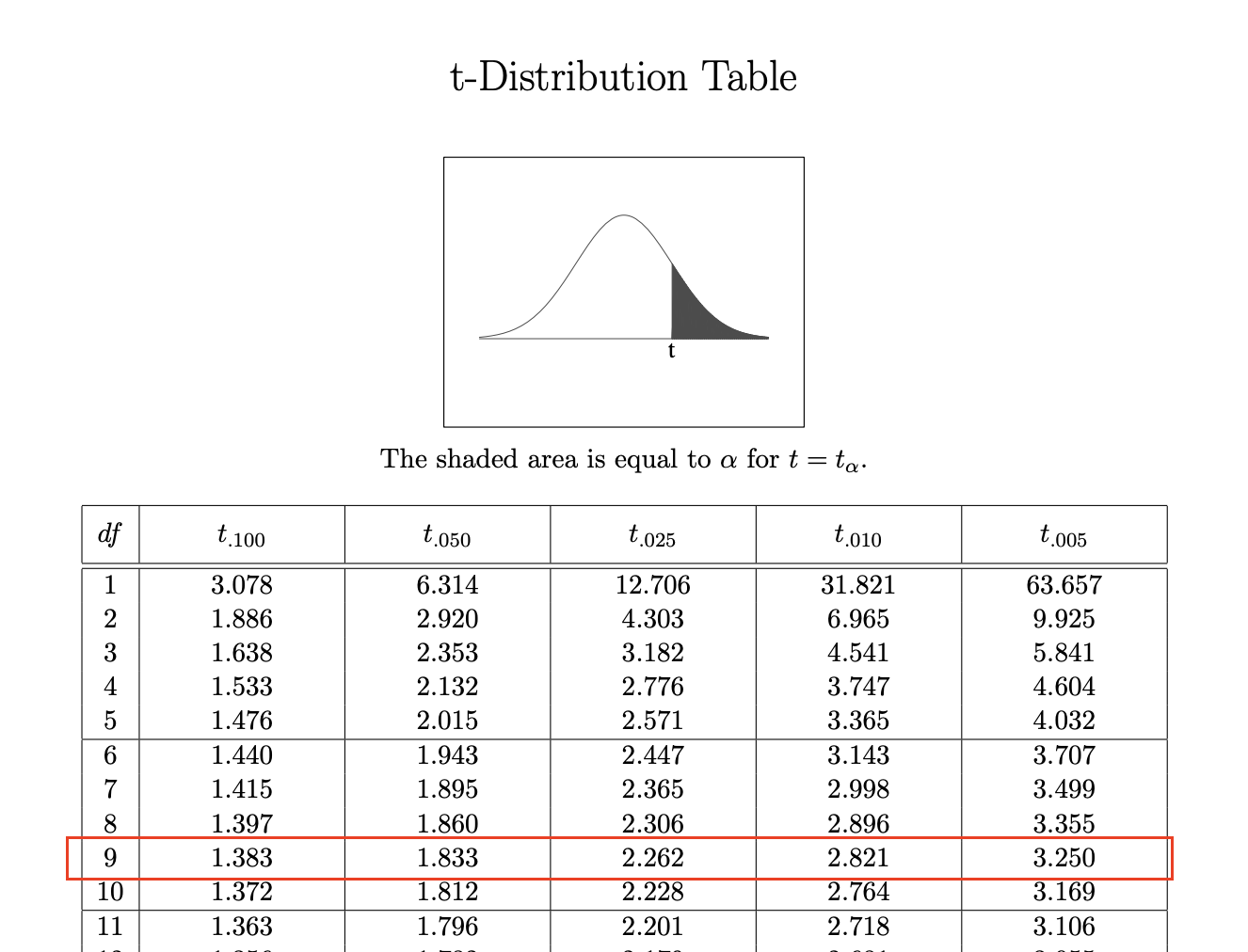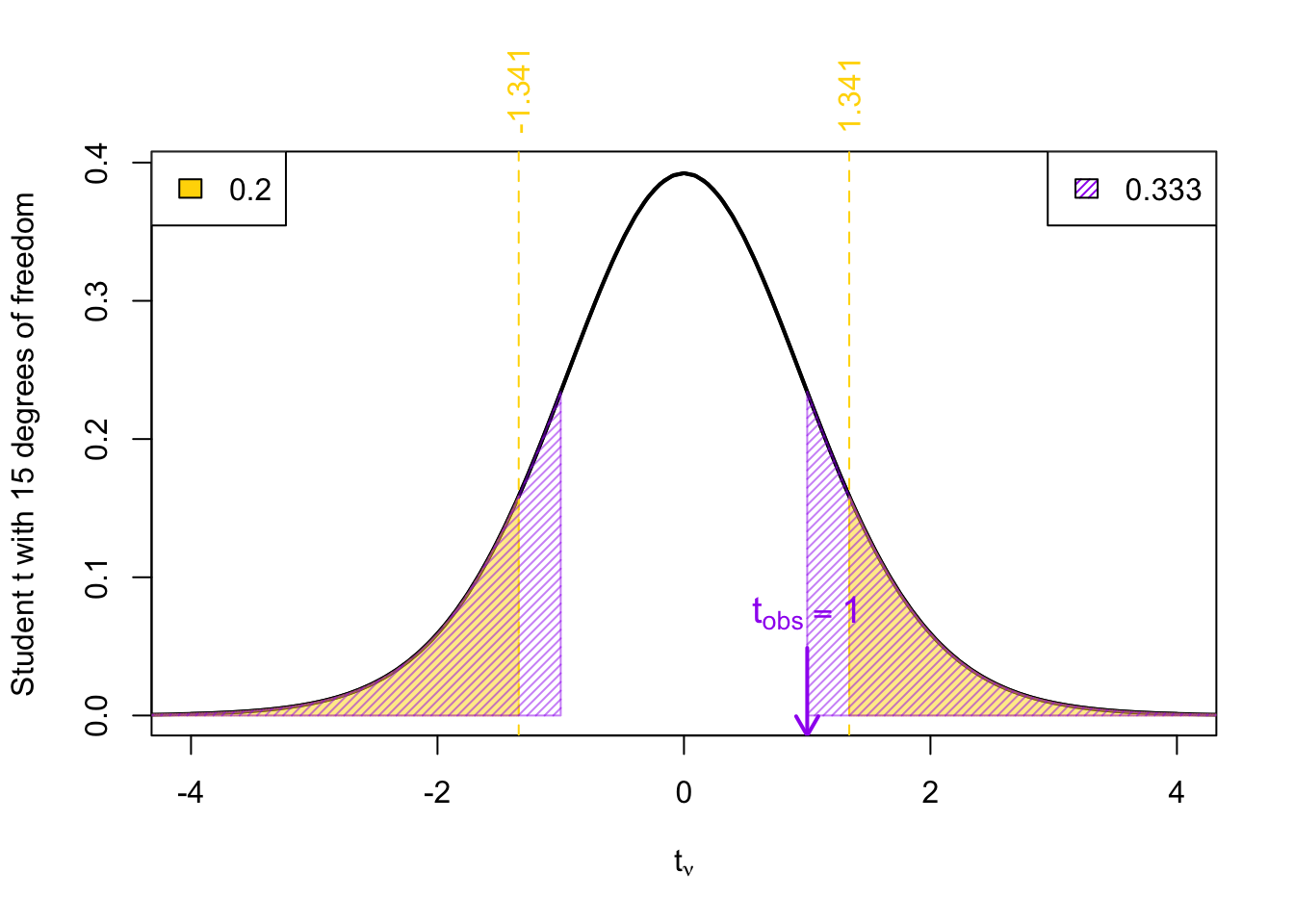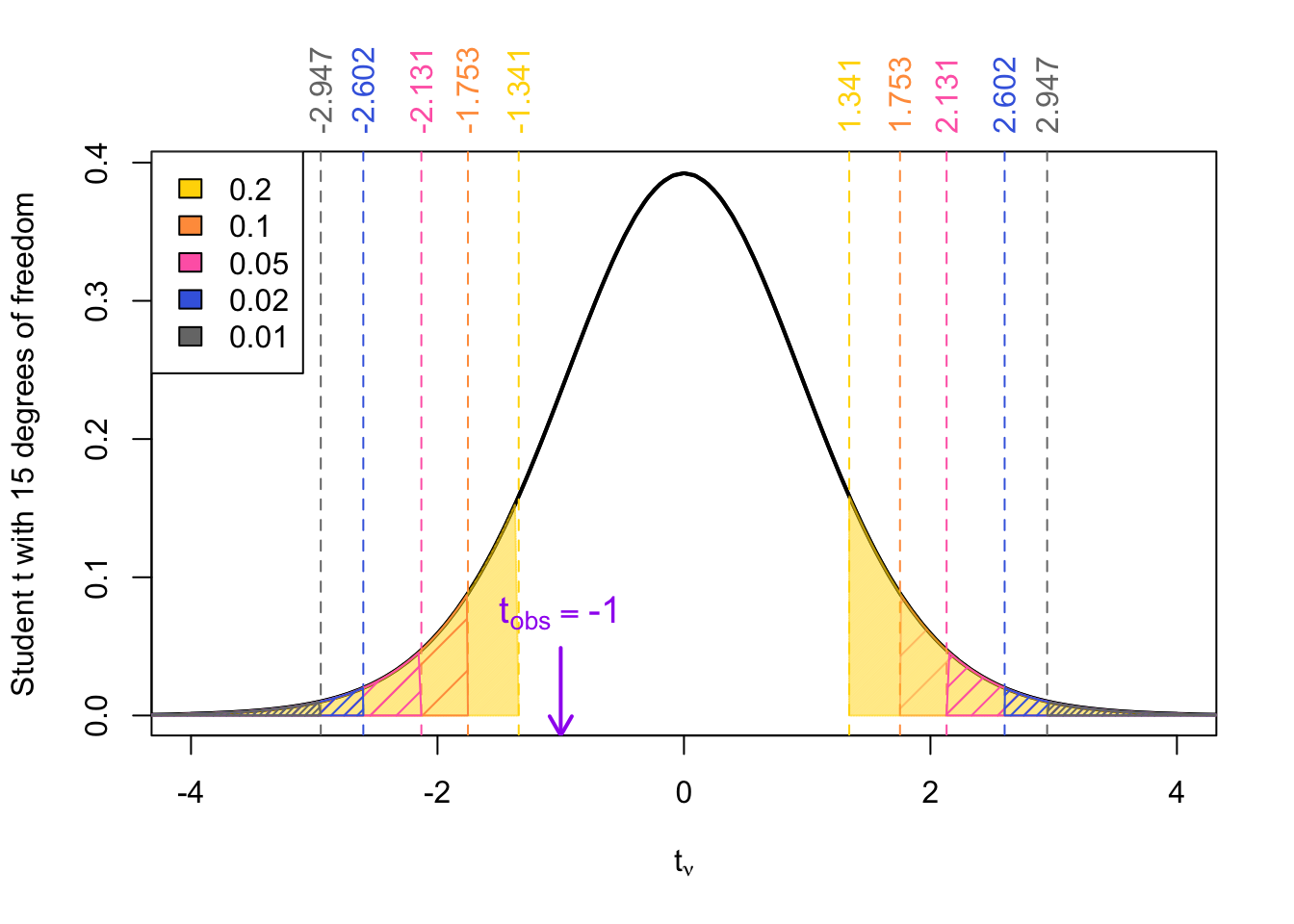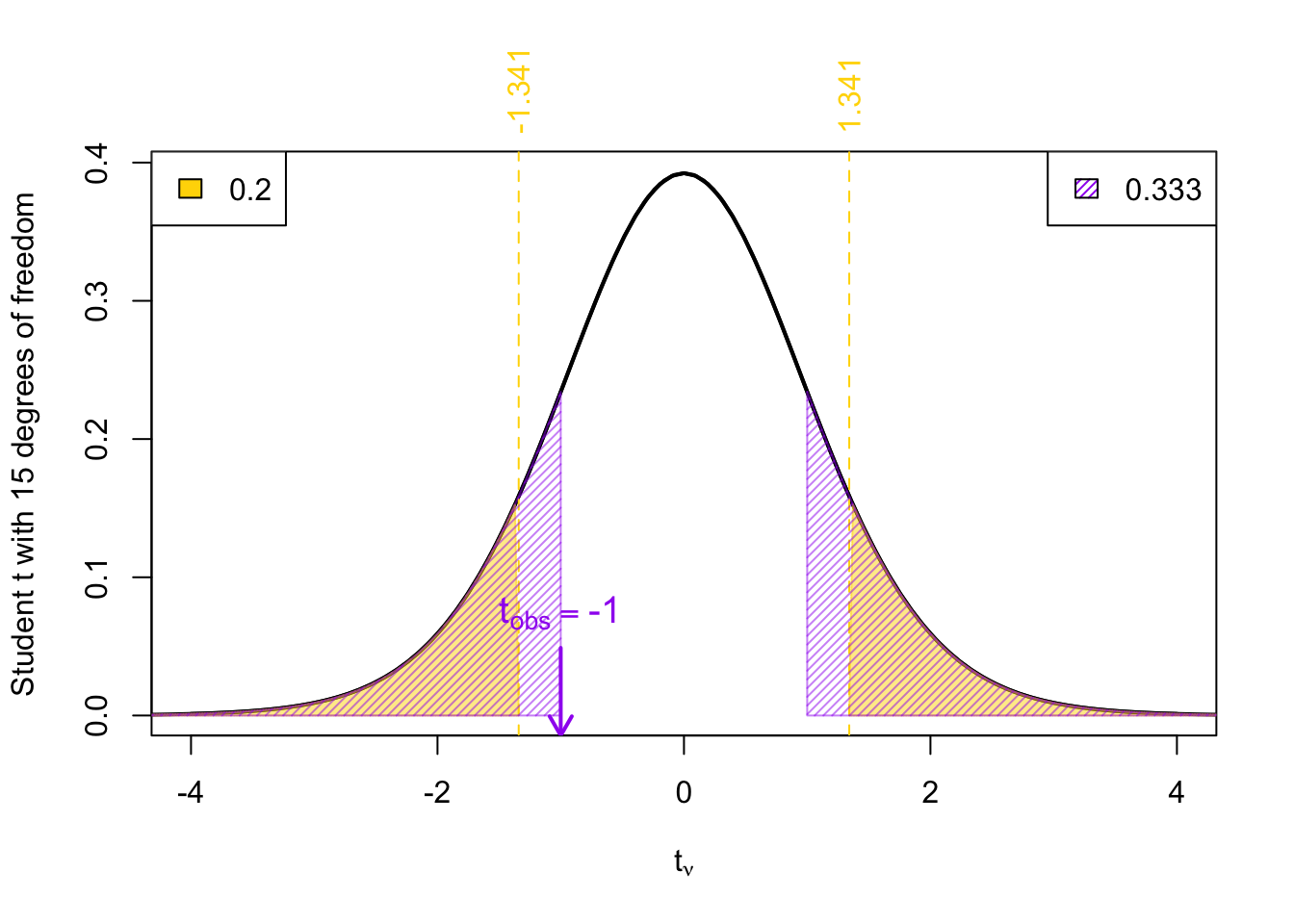
Approximate \(p\)-values using \(t\)-tables
STAT 205: Introduction to Mathematical Statistics
The document explains how we can approximate \(p\)-values from the \(t\)-table.
Steps for Computing \(p\)-values from \(t\)-tables
Step 1: Locate your degrees of freedom
Find the row in the table that matches your degrees of freedom (\(\nu\)).
Step 2: Find the reference \(t\)-values
On the row for your chosen \(\nu\), you’ll find five reference values corresponding to common upper-tail probabilities:
\[ t_{0.1}, t_{0.05}, t_{0.025}, t_{0.01}, t_{0.005} \]
For example, if we examine the row of the \(t\)-table with 9 degrees of freedom, we get the reference values: \(t_{0.1} = 1.383, t_{0.05}= 1.833, t_{0.025} = 2.262, t_{0.01} = 2.821, t_{0.005} = 3.25\)

Step 3: Compare your test statistic \(t_\text{obs}\) to the reference values
For upper-tailed \(p\)-values
- If \(t_{\text{obs}}\) falls between two reference values in the row → the \(p\)-value falls between the corresponding probabilities shown at the top of the columns.
- If \(t_{\text{obs}}\) is greater than all reference values in the row → the \(p\)-value is less than the smallest probability listed (0.005).
- If \(t_{\text{obs}}\) is smaller than all values → the \(p\)-value is greater than the largest probability listed.
For lower-tailed \(p\)-values
For lower-tailed tests, simply apply the same logic using the negative of the reference \(t\)-values for the appropriate degrees of freedom.

- If \(t_{\text{obs}}\) falls between two reference values in the row → the \(p\)-value falls between the corresponding probabilities shown at the top of the columns.
- If \(t_{\text{obs}}\) is greater than all negative reference values in the row → the \(p\)-value is greater than the largest probability listed (0.10).
- If \(t_{\text{obs}}\) is smaller than all negative reference values → the \(p\)-value is smaller than the smallest probability listed (0.050)
For two-tailed \(p\)-values

First, take the absolute value of your test statistic: \(|t_{\text{obs}}|\).
Compare \(|t_{\text{obs}}|\) to the positive reference values listed in the table.
Now determine where \(|t_{\text{obs}}|\) falls:
If \(|t_\text{obs}|\) falls between two reference values → the \(p\)-value falls between the corresponding two-tailed probabilities (i.e., twice the one-tailed probabilities shown at the top of the columns).
If \(|t_\text{obs}|\) is greater than all reference values → the \(p\)-value is less than twice the smallest probability listed (e.g., less than 0.01).
If \(|t_\text{obs}|\) is smaller than all reference values → the \(p\)-value is greater than twice the largest probability listed (e.g., greater than 0.2).
Computing exact \(p\)-values
In R we can of course compute the exact \(p\)-values using the pt() function.
Lower-tailed \(p\)-values
pt(t_obs, df, lower.tail = FALSE)Upper-tailed \(p\)-values
pt(t_obs, df, lower.tail = FALSE)Two-tailed \(p\)-values
2 * pt(abs(t_obs), df, lower.tail = FALSE)Examples
Upper-tailed test
For upper-tailed tests involving the null distribution \(t_{\nu}\), that is a Student \(t\)-distribution with \(\nu\) degrees of freedom, the \(p\)-value can be calculated as:
\[\begin{align} p\text{-value} &= \Pr(t_{obs} > t_{\nu}) \end{align}\]
where \(t_{obs}\) is our observed test statistic.
Example 1 Given a \(t_{obs}\) = 1 degrees of freedom \(\nu\) = 9
Example 2 Given a \(t_{obs}\) = 2.5 degrees of freedom \(\nu\) = 9
Example 3 Given a \(t_{obs}\) = 5 degrees of freedom \(\nu\) = 9
Lower-tail tests
For lower-tailed tests involving the null distribution \(t_{\nu}\), that is a Student \(t\)-distribution with \(\nu\) degrees of freedom, the \(p\)-value can be calculated as:
\[\begin{align} p\text{-value} &= \Pr(t_{obs} < t_{\nu}) \end{align}\]
where \(t_{obs}\) is our observed test statistic.
Example 4 Given a \(t_{obs}\) = 1 degrees of freedom \(\nu\) = 30
Example 5 Given a \(t_{obs}\) = -1.5 degrees of freedom \(\nu\) = 30
Given a \(t_{obs}\) = -3.2 degrees of freedom \(\nu\) = 30
Two-tailed tests
For two-tailed tests involving the null distribution \(t_{\nu}\), that is a Student \(t\)-distribution with \(\nu\) degrees of freedom, the \(p\)-value can be calculated as:
\[\begin{align} p\text{-value} &= 2 \times \Pr(t_{obs} < | t_{\nu}| ) \end{align}\]
where \(t_{obs}\) is our observed test statistic.
Example 6 Given a \(t_{obs}\) = 1 degrees of freedom \(\nu\) = 15
Given a \(t_{obs}\) = -1 degrees of freedom \(\nu\) = 15
Example 7 Given a \(t_{obs}\) = -1.5 degrees of freedom \(\nu\) = 15
Example 8 Find the two-sided \(p\)-value for \(t_{\text{obs}} = -3.5\) with \(\nu =15\) degrees of freedom.


















